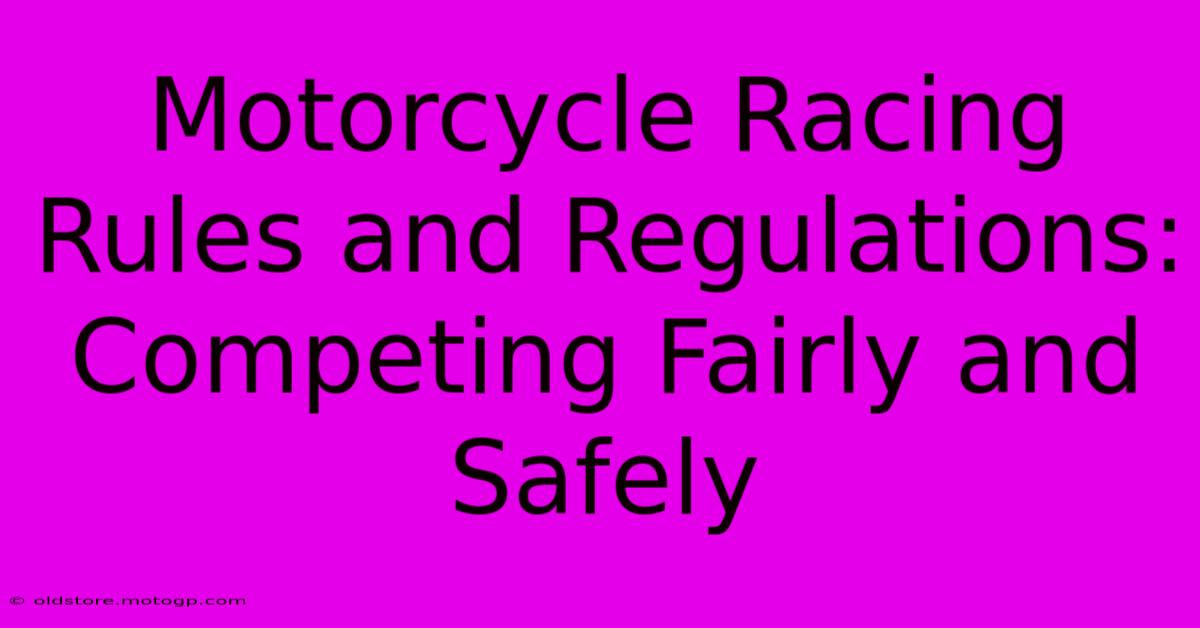Motorcycle Racing Rules And Regulations: Competing Fairly And Safely

Table of Contents
Motorcycle Racing Rules and Regulations: Competing Fairly and Safely
Motorcycle racing, a thrilling spectacle of speed and skill, demands strict adherence to rules and regulations to ensure fair competition and, most importantly, the safety of riders. This guide delves into the key aspects of these rules, covering everything from licensing and equipment to track etiquette and penalties. Understanding these regulations is crucial for both aspiring racers and seasoned veterans alike.
Licensing and Eligibility
Before even thinking about hitting the track, you'll need the proper licensing. Licensing requirements vary depending on the sanctioning body (e.g., AMA, FIM) and the class of racing. Generally, you'll need to demonstrate a certain level of experience and skill through successful completion of racing schools or prior racing experience. These licenses are crucial for proving your competency and ensuring you’re adequately prepared for the challenges of competitive racing. Always check the specific requirements of the sanctioning body you intend to race under.
Age Restrictions:
Many racing organizations have minimum age requirements, ensuring participants are mature enough to handle the physical and mental demands of motorcycle racing.
Motorcycle Equipment and Technical Regulations
Your motorcycle must meet stringent technical specifications to ensure fair competition and safety. These regulations typically cover:
- Engine Capacity and Modifications: Strict limits are placed on engine size and modifications to prevent unfair advantages. Engine modifications are often meticulously inspected before races.
- Frame and Chassis: Rules often govern the frame's material, construction, and geometry to maintain a level playing field.
- Safety Equipment: This is paramount! Regulations mandate specific safety gear, including:
- Helmets: Must meet stringent safety standards (e.g., Snell, FIM).
- Racing Suits: Leather suits designed to protect against abrasion and impact.
- Gloves and Boots: Provide protection and grip.
- Back Protectors: Essential for spinal protection.
- Tires: Tire specifications, including brand, size, and compound, are usually regulated.
Failure to comply with these technical regulations can result in disqualification.
Track Etiquette and Fair Play
Beyond the technical aspects, respecting track etiquette is vital for maintaining a safe and fair racing environment. This includes:
- Respecting Flag Signals: Understanding and responding appropriately to race officials' flag signals (e.g., yellow flags for caution, red flags for race stoppage) is non-negotiable. Ignoring these signals can lead to serious accidents and penalties.
- Safe Overtaking: Overtaking maneuvers must be conducted safely and without causing collisions. Aggressive or reckless overtaking is strictly prohibited.
- Sportsmanship: Maintaining good sportsmanship towards fellow racers is crucial. Unnecessary contact or aggressive riding that endangers other competitors will not be tolerated.
- Following Race Officials' Instructions: Always comply with instructions given by race officials and marshals.
Penalties and Disciplinary Actions
Breaching the rules and regulations outlined above can lead to a range of penalties, including:
- Warnings: For minor infractions.
- Time Penalties: Added to the racer's finishing time.
- Disqualification: Removal from the race results.
- Suspension: Temporary or permanent ban from racing.
- Fine: Monetary penalties.
The severity of the penalty depends on the nature and severity of the infraction. Repeated infringements can lead to progressively harsher penalties.
Conclusion: The Importance of Rules and Regulations in Motorcycle Racing
Motorcycle racing rules and regulations aren't just a set of arbitrary guidelines; they are the cornerstones of fair competition and rider safety. By understanding and adhering to these rules, racers contribute to a safer, more enjoyable, and more competitive racing environment for everyone involved. Remember to always consult the official rulebook of the sanctioning body for the most up-to-date and detailed information.

Thank you for visiting our website wich cover about Motorcycle Racing Rules And Regulations: Competing Fairly And Safely. We hope the information provided has been useful to you. Feel free to contact us if you have any questions or need further assistance. See you next time and dont miss to bookmark.
Featured Posts
-
Make A Statement On The Road Eye Catching Replica Helmets
Feb 20, 2025
-
Gp Results Empowering You To Make Informed Decisions
Feb 20, 2025
-
Experience The G Force Tnt Moto Gp
Feb 20, 2025
-
Maximize Your Moto Gp Experience Tnt Sports Schedule
Feb 20, 2025
-
Find Your Way Around Cota The Formula 1 Austin Map
Feb 20, 2025
